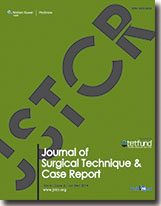 |
July-December 2014
Volume 6 | Issue 2
Page Nos. 49-72
Online since Thursday, December 18, 2014
Accessed 9,791 times.
PDF access policy
Full text access is free in HTML pages; however the journal allows PDF access only to users from NIGERIA, developing countries and paid subscribers.
EPub access policy
Full text in EPub is free except for the current issue. Access to the latest issue is reserved only for the paid subscribers.
|
| |
|
|
Show all abstracts Show selected abstracts Add to my list |
|
| CASE REPORTS |
|
|
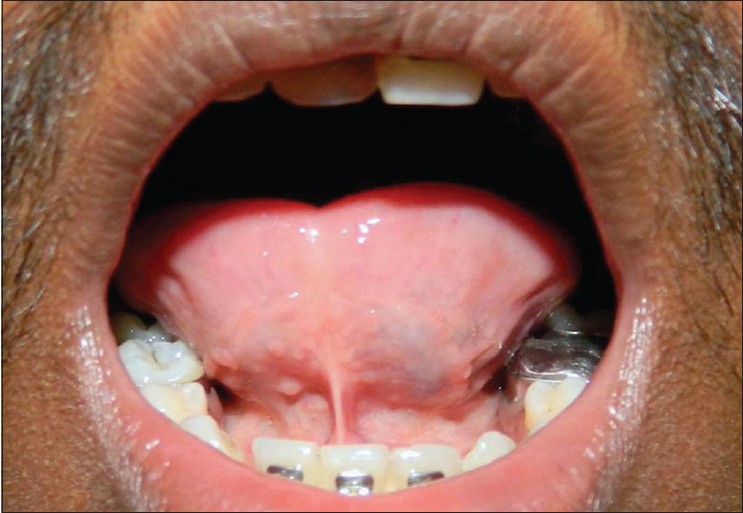  |
A Novel surgical pre-suturing technique for the management of ankyloglossia  |
p. 49 |
Mayur Khairnar, Babita Pawar, Darshana Khairnar
DOI:10.4103/2006-8808.147259 PMID:25598942Ankyloglossia or "tongue-tie" is a congenital anomaly caused by tight lingual frenulum that abnormally connects the tongue base to the floor of the mouth. Ankyloglossia can results in difficulty during speech and deglutition. This case series presents a novel surgical technique in the management of ankyloglossia in using presuturing technique in which different sets of sutures are given on lingual frenum before severing it. This results in reduced opening of the wound, minimal bleeding, pain and discomfort. Two male patients with severe ankyloglossia had been managed with this technique and after 2 years of follow-up of these cases showed satisfactory protrusive and lateral movement of the tongue with minimal scarring and discomfort. |
| [ABSTRACT] [HTML Full text] [PDF] [Mobile Full text] [EPub] [PubMed] [Sword Plugin for Repository]Beta |
|
|
|
|
|
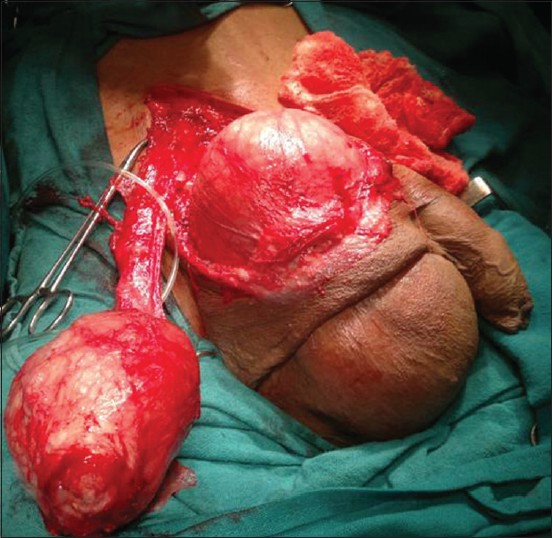  |
Transverse testicular ectopia with bilateral pyocoele: Case report and brief review of literature
|
p. 55 |
Lokendra Kumar, Praveen Garg, ASN Rao, Ashish Kumar
DOI:10.4103/2006-8808.147260 PMID:25598943Transverse testicular ectopia (TTE) is a rare anomaly in which both testis descend through a single inguinal canal and enter to same hemiscrotum. To the best of our knowledge, we are reporting a new variant of TTE with right inguinal hernia with bilateral pyocoele. In this case, both testes descend separately through corresponding inguinal canal and present in single right scrotum. There is no report of bilateral orchidectomy for this variant of TTE with bilateral pyocoele with calcified necrosed testes. We also describe its embryology and management in brief, and review the previously reported cases. |
| [ABSTRACT] [HTML Full text] [PDF] [Mobile Full text] [EPub] [PubMed] [Sword Plugin for Repository]Beta |
|
|
|
|
|
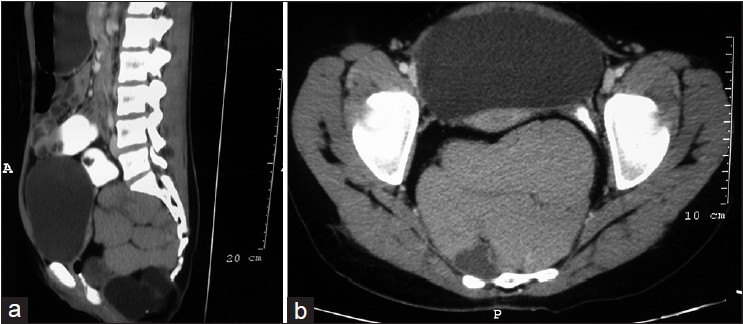  |
Retrorectal cystic hamartoma: A problematic 'Tail' |
p. 58 |
Suhani , Kusum Meena, Shadan Ali, Lalit Aggarwal, Shaji Thomas
DOI:10.4103/2006-8808.147261 PMID:25598944The retrorectal space is an uncommon seat for neoplastic masses. Retrorectal hamartoma or tailgut cyst (TGC) is an uncommon developmental cystic lesion occurring in this space which mostly occurs in middle-aged females. We recently cared for a 16-year-old girl who presented with vague lower abdominal pain and occasional constipation. Per rectal examination revealed an extraluminal mass bulging from posterior rectal wall. Preoperative radiological investigations revealed by suggested it to be a mature cystic teratoma. The patient underwent exploratory laprotomy with en masse excision of the cyst. Histopathological examination of the specimen showed it to be a TGC. This case highlights the possibility of a TGC as a differential for retrorectal cystic lesions and the need to completely excise them given the possibility of future malignant transformation. |
| [ABSTRACT] [HTML Full text] [PDF] [Mobile Full text] [EPub] [PubMed] [Sword Plugin for Repository]Beta |
|
|
|
|
|
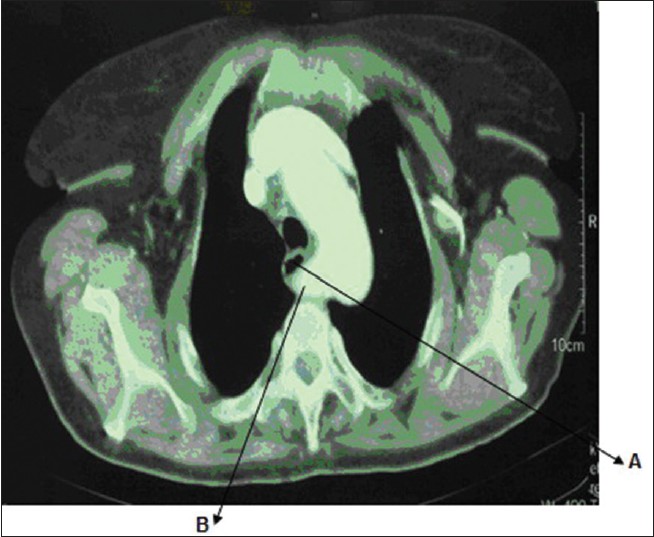  |
Aberrant right subclavian artery: A life-threatening anomaly that should be considered during esophagectomy |
p. 61 |
Rahim Mahmodlou, Nariman Sepehrvand, Sanaz Hatami
DOI:10.4103/2006-8808.147262 PMID:25598945Aberrant right subclavian artery (ARSA) is a rare anomaly, in which the right subclavian artery arises directly from the aortic arch instead of originating from the brachiocephalic artery. This anomaly should be taken into consideration during surgical procedures around esophagus, such as esophagectomy. Any unintentional injury of this artery during surgical procedures could be extremely life threatening. A 56-year-old woman presented with dysphagia, with concurrent aberrant subclavian artery and esophageal cancer. The transhiatal esophagectomy was performed successfully since the anomaly was preoperatively diagnosed using computed tomography scan. The presence of ARSA during esophagectomy may be challenging, but if diagnosed preoperatively, the precise and diligent dissection of the retroesophageal space during esophagectomy, may prevent any injury to the aberrant artery and consequent complications. |
| [ABSTRACT] [HTML Full text] [PDF] [Mobile Full text] [EPub] [PubMed] [Sword Plugin for Repository]Beta |
|
|
|
|
|
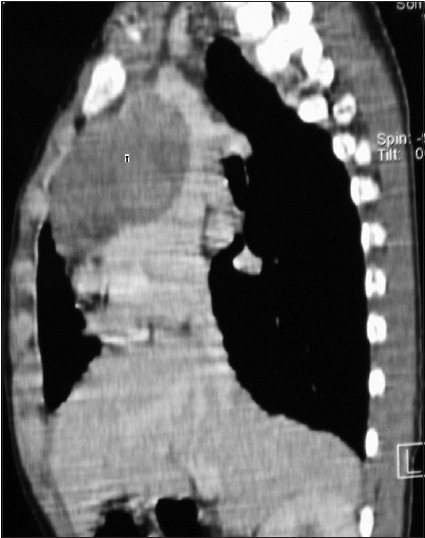  |
Pediatric thymoma with a difference: Report of a case and review of literature
|
p. 64 |
Sudipta Saha, Suhani Suhani, Animesh Basak, Nitin Agarwal, Pooja Dewan
DOI:10.4103/2006-8808.147263 PMID:25598946Thymoma represents <1% of all mediastinal tumors in children. Less than 50 cases of pediatric thymoma are reported in the literature. Thymomas are considered to be highly aggressive in pediatric patients, especially when age is <10 years. Paraneoplastic syndromes, of which around 70% are myasthenia gravis, correlate with poor prognosis. In this article, we report a case of a thymoma in an 8-year-old boy, who had favorable histopathology (Masaoka stage I, WHO type B2), despite the presence of young age and necrosis along with absence of myasthenia gravis. We have also reviewed the available literature on pediatric thymoma. |
| [ABSTRACT] [HTML Full text] [PDF] [Mobile Full text] [EPub] [PubMed] [Sword Plugin for Repository]Beta |
|
|
|
|
|
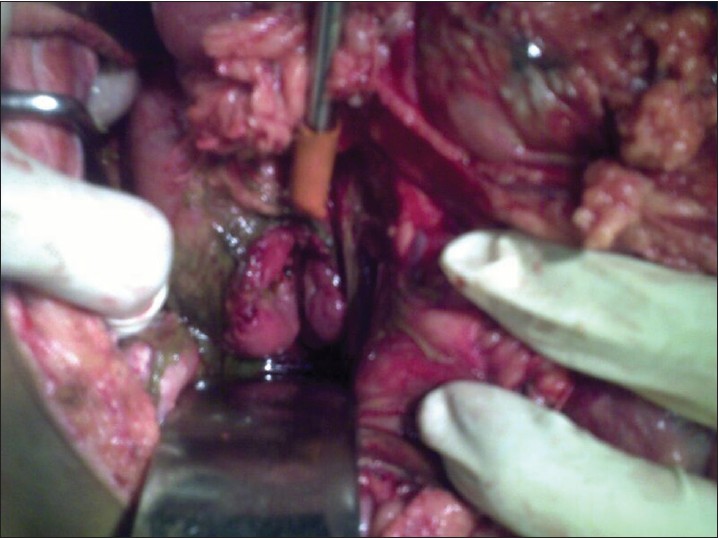  |
Duodenal transection without pancreatic injury following blunt abdominal trauma
|
p. 67 |
Sanket Subhash Bankar, Vikas S Gosavi, Mohd Hamid
DOI:10.4103/2006-8808.147264 PMID:25598947With the inventions of faster cars and even more faster motorbikes there is a worldwide increase in road traffic accidents, which has increased the incidence of blunt abdominal trauma but still duodenal injury following a blunt abdominal trauma is uncommon and can pose a formidable challenge to the surgeon and failure to manage it properly can result in devastating results. It may typically occur in isolation or with pancreatic injury. Here, we report a case of an isolated transection of the third part of the duodenum with normal pancreas following a blunt abdominal trauma. The initial clinical changes in isolated duodenal injury may be extremely subtle before life-threatening, peritonitis develops. Hence, a high index of suspicion, on the basis of mechanism of injury and physical examination is the key in early detection of duodenal injury especially in a rural hospital like ours where the facilities for computed tomography scan are not available. |
| [ABSTRACT] [HTML Full text] [PDF] [Mobile Full text] [EPub] [PubMed] [Sword Plugin for Repository]Beta |
|
|
|
|
|
|
| LETTERS TO EDITOR |
 |
|
|
|
Endotracheal intubation challenges to oral cavity - prevention strategy |
p. 70 |
Preetinder Singh, Samir Anand
DOI:10.4103/2006-8808.147265 PMID:25598948 |
| [HTML Full text] [PDF] [Mobile Full text] [EPub] [PubMed] [Sword Plugin for Repository]Beta |
|
|
|
|
|
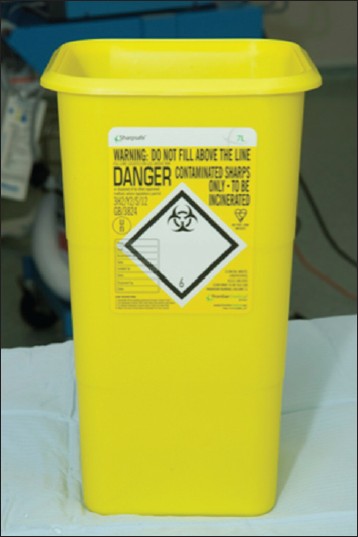  |
A useful adjunct in lower limb surgery
|
p. 70 |
Zeeshan Ahmad, Marcus J Davies
DOI:10.4103/2006-8808.147266 PMID:25598949 |
| [HTML Full text] [PDF] [Mobile Full text] [EPub] [PubMed] [Sword Plugin for Repository]Beta |
|
|
|
|
|
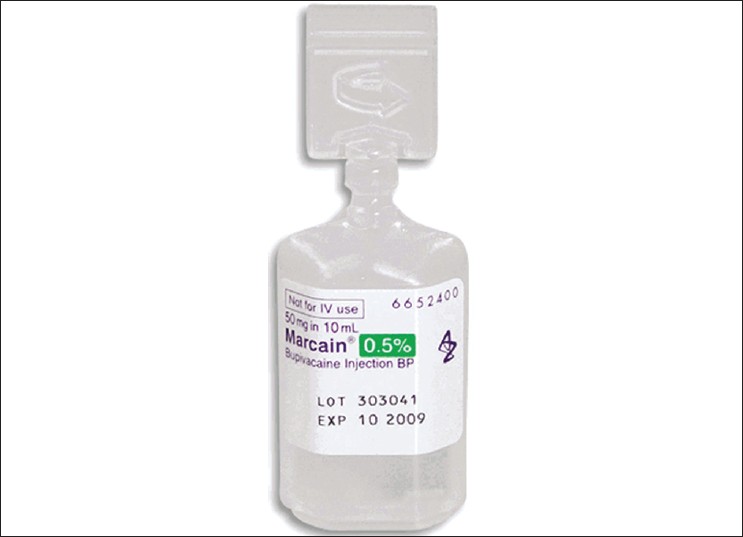  |
Use of labels on local anaesthetic syringes
|
p. 71 |
Z Ahmad
DOI:10.4103/2006-8808.147267 PMID:25598950 |
| [HTML Full text] [PDF] [Mobile Full text] [EPub] [PubMed] [Sword Plugin for Repository]Beta |
|
|
|
|
|